| | Triticale grain for swine and hog feed | Triticale grain for poultry feed | Triticale grain for ruminants | Triticale grain for dairy cattle | Triticale grain for feedlot beef | Triticale grain for sheep feed | Triticale grain for horse feed
Triticale Grain for Swine and Hog Feed
According to Canadian and Australian studies, triticale can be included without restriction as a high value, consistent quality cereal grain in least-cost formulations for growing pigs. It may be used in either ground or pelleted form. Comprehensive nutritional data and feed recommendations for triticale feed use with swine based on Canadian research are still unavailable.
However:
- Triticale digestible energy (DE) levels for swine and protein composition are superior to barley. Triticale DE is equivalent to wheat when used as swine feed, and to corn when fed to young pigs.
- Triticale is often the preferred grain feed for pigs in Australia. Since the development of modern Australian triticale varieties, feed intake problems are no longer being reported there.
- In Australian trials, digestibility in the ileum (a portion of the small intestine) of dry matter, N and amino acids in pigs fed triticale was generally higher than for barley. The exception was the amino acid proline, which was more digestible in barley (van Barneveld, 2002).
The superior protein quality and high yield potential of triticale grain has kept up the international interest in using the crop as a swine feed. Generally, reports show that using triticale as a swine feed has been very successful. Producers have been able to replace other cereals, (e.g. wheat, corn, barley and millet) with triticale without losing productivity or product quality. Triticale is also more cost-effective than its competitors, as its high lysine content means less protein supplements are required. Australia, the United States, Brazil, Poland and Germany have all adopted triticale for commercial swine rations. It is only now starting to occur in Western Canada.
The reference section of this manual lists literature supporting favorable results from feeding triticale to swine. There are only a few Canadian studies reported.
Two Canadian studies (Robertson et al, 1998; Jaikaran et al, 1998) compared 100 percent Pronghorn triticale as the grain source to:
- 100 percent corn.
- 100 percent hulless barley.
- a 50:50 mix of hulless barley and Pronghorn triticale.
The studies compared 25 production, carcass and meat quality characteristics. Triticale performed similarly to the corn (control) diet for 24 characteristics, and similarly to the 50:50 hulless barley and Pronghorn triticale mixture in all cases. The conclusion was that triticale could be successfully substituted for maize or hulless barley in the diets of growing-finishing (25-110 kg) pigs (Tables 7 and 8).
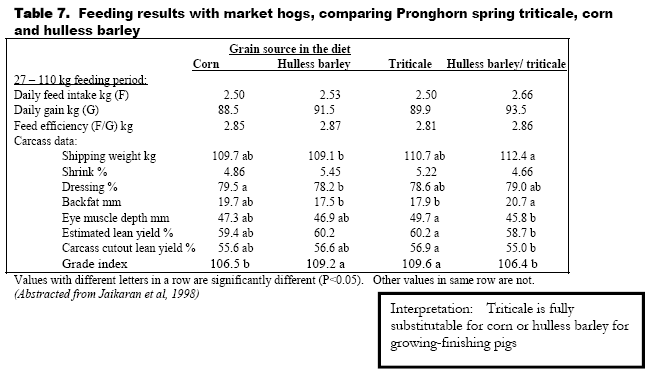
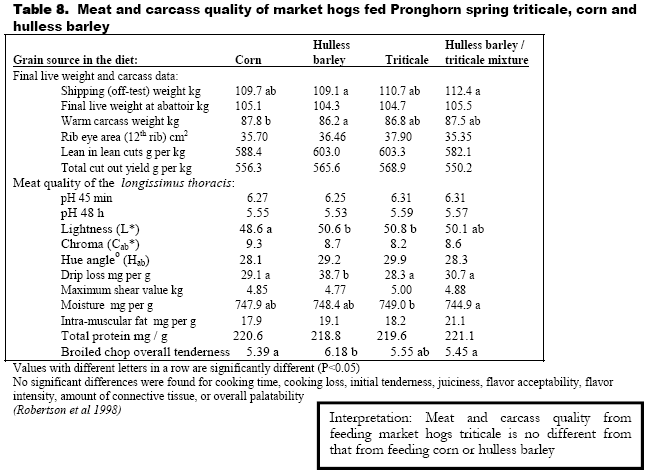
The Ohio State University Tri-State Swine Nutrition Guide (1998) recommends that triticale can be used at maximum rates in amounts equal to or greater than barley in the diets of grow-finish, gestating, and lactating swine, and in amounts equal to or greater than for wheat. The guide also suggests that triticale can be used for up to 10 percent of the feed for starter swine feed. This is compared to a zero percent recommendation for wheat, and 15 percent for barley (Table 9).
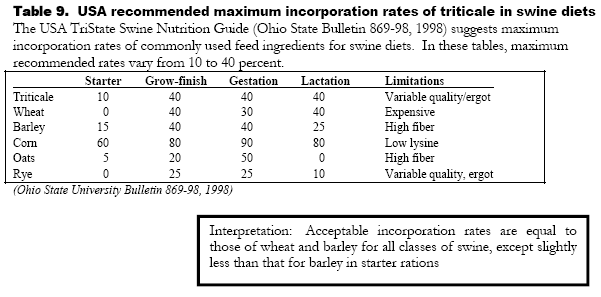
An Australian study (Edwards, 1998) concluded that the newest triticale varieties were likely free of the anti-nutritional compounds that had caused problems in earlier varieties. The study found that “the most recent reports of triticale performance in pig and poultry diets confirms triticale to be equal to or better than wheat and maize.” This view is obviously popular; triticale is now commonly used for swine rations in the Australian swine industry and elsewhere.
Despite its popularity elsewhere, triticale is now just beginning to be used in Western Canada as a swine feed. Its growth has been limited by a number of factors, including:
- Unfamiliarity with triticale feed properties for swine. Many producers are unsure what the optimal formulations are for various feed combinations.
- Lack of a grain supply.
- Lack of storage bins at feeder sites.
- Lack of a locally validated feed compositional database established using the newest Canadian varieties.
- Uncertainty among producers as to whether or not anti-nutritional characteristics should still be a concern, or whether these will affect feed intake.
Despite not being widely acted on in Canada, the general scientific consensus is that triticale is an excellent feed choice for swine. Its use results in few to no feeding problems, and it is substitutable for other grains. When triticale is substituted, ration costs are lower because less soymeal or other protein meal supplements are needed.
In recent studies, researcher van Barneveld (1998, 2002) concluded that when modern Australian triticale varieties are formulated in diets to supply levels of digestible amino acids and digestible energy equal to that in wheat-based diets, the performance of growing pigs is equal or better than when fed the wheat-based diets. This study also indicated that triticale can be used in swine diets without restriction.
Other Australian results quoted from Cooper (Table 10) conclude that the energy levels in modern Australian varieties are reliable and consistent across locations and varieties, and averaged 13.7 MJ/kg (infrared spectroscopy basis).

Triticale can also be included in diets for young pigs without causing palatability problems.
In the United States, Myer (2002) conducted five trials with early-weaned pigs comparing the suitability of triticale to corn for this age group. It was necessary to carry out the study for this age group, as pigs up to five weeks old are not yet fully efficient at digesting energy from cereals. In these tests:
- The pigs were 3 to 8 weeks old, and from 5 to 25 kg body weight.
- The grain proportion was between 55 to 65 percent of the total diet weight, and was standardized for lysine content.
- The triticale averaged 30 percent more protein and 40 percent more lysine than the corn.
- Triticale fiber content was higher than for corn and fat content was lower. As such, the triticale contained five percent less metabolizable energy than did the corn.
- Averaged over three trials, the daily weight gain for the diets using triticale was five percent higher than for the corn-based diet (Table 11).
The overall conclusion was that “triticale is an effective replacement for corn in diets for growing pigs, including diets for early weaning pigs.”
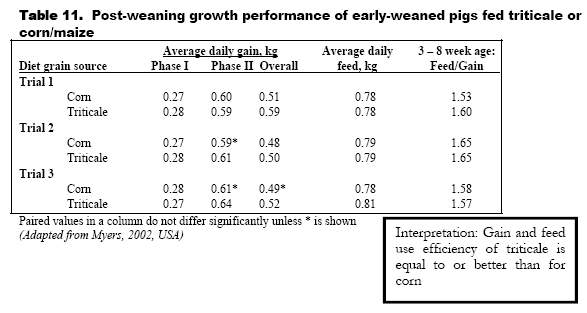
Triticale Grain for Poultry Feed
Triticale is already widely used for feeding poultry around the world, especially in countries with large triticale acreage.
Recent Alberta results from both small-scale experimental trials and in a large-scale production trial by Korver and Zuidhof (Tables 12 and 13) show that triticale has a great potential as a feed for broiler chickens.
These trials suggest that for live performance and production costs, triticale could replace Canada Western Red Spring wheat in the diet at a cost reduction of approximately 5 percent. Triticale is a non-Canadian Wheat Board grain, which could provide additional cost savings. This cost saving result is very similar to that found by the International Maize and Wheat Improvement Centre (CIMMYT) in Mexico, from an economic study based on international grain prices.
In the commercial scale Alberta trial (Table 13), Korver and Zuidof found that the following were not significantly different when feeding broilers a triticale diet than when feeding a wheat diet:
- Final body weight
- Feed consumption
- Carcass weight at processing
- Flock uniformity
- Percentage of grade-A carcasses
- Percentage of condemned carcasses
Triticale grain use for broilers and laying hens may cause sticky droppings similar to barley or wheat. Adding commercial enzymes to the diet will solve this problem.
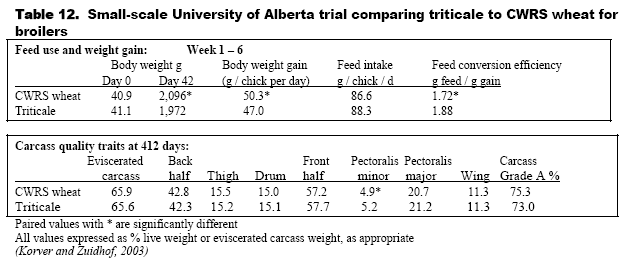
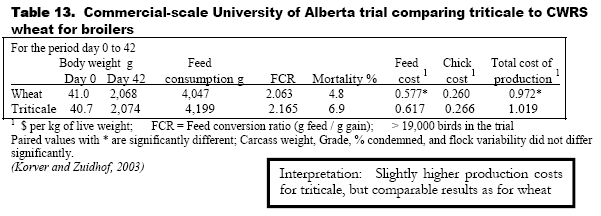
Compared to wheat or corn, triticale is generally reported as having superior levels and availability of important amino acids for monogastric animals. However, depending on specific variety comparisons, the protein concentration in newer varieties is often lower than in wheat.
Several studies have looked at protein quality in newer varieties that have a protein concentration in the 10-13 percent range. These include a Saskatchewan study by Salmon (1984), as well as those by Johnson and Eggum (1988), and Myer et al (1996, 2002). All of these have sparked a continuing interest in triticale for broiler diets.
Despite the perceived protein superiority of triticale, its use in the poultry diet has often resulted in poorer production compared to wheat or corn. This is because the large plump kernels of newer triticale varieties have a lower ratio of protein to starch in the kernel.
Some studies have shown that negative effects of triticale do not occur when the triticale grain fraction in the diet is limited to as little as 15 percent of the grain portion of the diet. However, other studies with broilers and egg production show no differences in productivity, even when diets consist of 100 percent triticale (Maurice et al, 1989; Karunajeewa and Tham, 1984; Boros, 1999; Leeson and Summer, 1987; Yaqoob and Netke, 1975; McNab and Shannon, 1975; Fayez et al, 1996). Savage et al (1987) reported that increasing the triticale content in the diet actually improved the physical and sensory quality of cooked meat from turkey toms.
In Oregon, USA trials, Nakaue and Boldaji (no date) used the local winter triticale variety ‘Celia’ in triticale-barley-soybean and triticale-barley-corn-soybean mixtures fed to layers. The results were compared to the control diet of corn-soybean.
No differences were found for:
- Hen-day egg production
- Feed conversion
- Daily egg mass produced
- Interior egg quality
- Shell thickness
- Body weight gain
Egg yolk color from the triticale-fed chickens was lighter than yolks produced by the control group. The feed consumption was lower in the triticale-fed birds than in the control group but egg quality remained the same. Nakaue and Boldaji concluded that the decision to use triticale should depend on its price relative to corn and whether enough supply is available.
In economic studies of broiler and layer rations, Abderrezak-Belaid (1994) showed that “the inclusion of triticale leads to cost savings resulting from the complete replacement of maize and from a considerable reduction of soybean meal in the rations.” The study found cost reductions from using triticale ranged from 1.3 to 2.3 percent for broiler rations and from 1.87 to 3.54 percent for layer rations when triticale was priced equal to corn. When triticale was priced at 95 percent of corn, these cost reductions were 4.5 to 7.2 percent for broiler rations, and 6.92 to 8.0 percent for layer rations.
A recent study by Santos et al. (2005, unpublished) found that colonization of the Salmonella bacteria in turkeys was discouraged by diets containing high non-starch polysaccharide content from wheat and triticale. Further, addition of enzymes reduced Salmonella colonization in turkeys fed triticale or wheat compared to corn.
Triticale Grain for Ruminants
Triticale grain is a useful energy source for ruminants because it:
- Contains high energy levels.
- Contains starch that is readily digested in the small intestine.
As with other grains fed to ruminants, special care should be taken when feeding triticale grain to avoid digestive disorders arising from acidosis.
Triticale, and starch and protein digestion in ruminants
Ruminant animals such as cattle and sheep have a limited ability to digest energy sources including starch in the small intestine, even though energy digestion in the small intestine is much more efficient than in the rumen.
Fermentation in the rumen is an important first part of the digestion of cereals such as triticale, but when it is incomplete, unfermented starch moves through to the other parts of the digestive system.
Thus starch utilization from any cereal grain source depends on:
- Whole digestive tract digestibility
- The extent of starch digestion in the rumen and small intestine, and
- The amount of lactic acid produced in the rumen and hind gut (van Barneveld, 2002).
Recent Australian research (Figure 3) demonstrated that triticale has similar capacity for starch fermentation as barley and oats, but has a higher enzyme digestion capacity. Further research is needed to demonstrate that this translates into higher energy availability for ruminant animals, but energy levels from other feeding experiments give favorable energy values for triticale thus far.
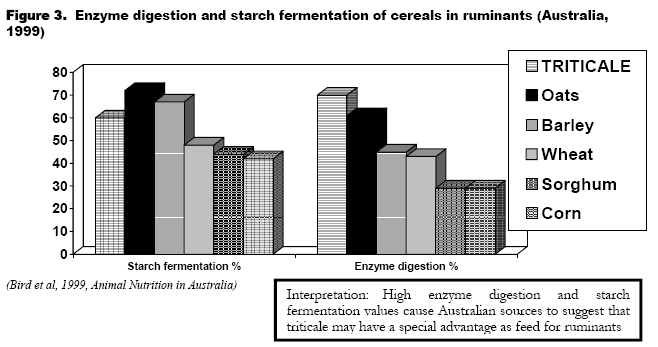
Triticale Grain for Dairy Cattle
Concentrates used in modern dairy cattle rations require feed sources with high energy value. Triticale is a suitable component for such feeds and helps produce high milk yield, quality and protein. Research data on triticale grain use in concentrates for dairy cattle is very sparse. However, this use of the grain is now conventional in Australia when price and supply are competitive with other high energy grains.
In a Canadian study in New Brunswick, McQueen and Fillmore (1991) fed lactating Holstein dairy cows three different grain rations:
- 100 percent barley
- 57 percent barley plus 43 percent triticale
- 86 percent triticale plus 14 percent barley
Alfalfa silage (15 percent crude protein and 62.2 percent dry matter digestibility) was fed ad libidum.
The grain ration was fed at 1 kg per day per 2.75 kg of milk produced. The trial ran for 11 weeks and found (Table 14) that:
- Grain rations containing triticale were well consumed by the cows. Milk yields and quality were similar to that from the barley ration.
- Cows fed triticale gained less weight, indicating that more of the productive energy was expressed in milk production.
Research data on triticale grain use in concentrates for dairy cattle is very sparse, but this use of the grain is now conventional in Australia when price and supply is competitive with other high energy grains.
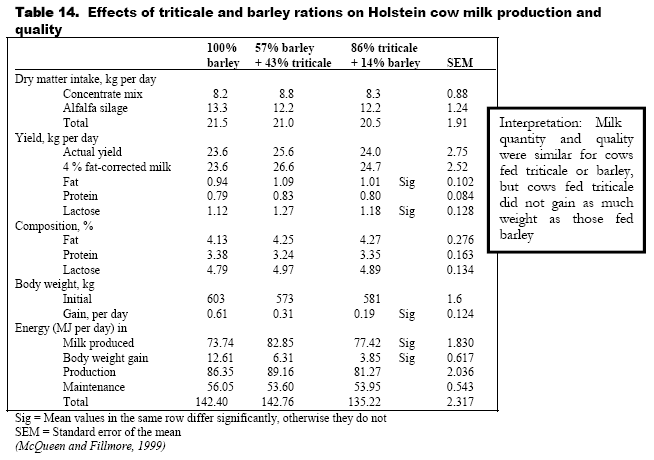
Triticale Grain for Feedlot Beef
In countries where a regular triticale supply chain exists, triticale grain is commonly used as a high energy, low-cost grain source for feeding cattle. Although Canadian data is lacking, international results show triticale grain can be fully substituted for other feed grains in feed concentrates without loss of feed intake, overall digestibility or feedlot performance.
Large feedlot operators in Western Canada have used triticale grain for cattle feed, often in combination with triticale silage and other grain or legume silage. According to limited Canadian survey results, these operators have opted for triticale grain because of its low cost and high-energy value.
Research data on this use of triticale grain in Canada are lacking, reflecting the absence of a developed supply chain for grain for use in the feed industry. Limited data are available from the United States and Australia.
Caution has to be used when high levels of triticale and other grains are fed to beef cattle as the primary energy source. Using buffering additives or improving grain processing can help to avoid acidosis and digestive upsets. Coarse cracking of the grain by grinding or rolling can also reduce feeding problems.
When the above precautions are taken, cereals such as triticale can constitute the bulk of feedlot beef rations when supplemented with:
- Roughage (from hay or silage).
- Vitamins and minerals.
- Protein sources added to meet requirements.
In the United States, Hill and Utley (1989) conducted two trials on finishing steers, comparing feedlot corn rations, feedlot corn/triticale rations and feedlot triticale rations. Evaluations of steer performance and carcass quality traits indicated few differences amongst the treatment effects (Table 15). They concluded that “new triticale varieties produce grain that can be substituted for conventional grains in finishing steer diets.”
In the United States, Lofgren (University of California) conducted a trial to compare different diets each with 68 percent grain content using Brahman x British cattle of initial weight of around 733 lbs.
Diets compared included:
- 100 percent barley.
- 100 percent triticale.
- 50/50 barley/triticale mixture.
The remaining ration comprised:
- 5 percent alfalfa hay.
- 5 percent Sudan hay.
- 10 percent beet pulp.
- 0.5 percent urea.
- 3 percent fat.
- 7 percent molasses.
- 1 percent limestone.
- 0.5 percent trace mineralized salt.
- 1,000 IU vitamin A per lb of ration.
For all but two traits measured, the performance of the triticale was considered equivalent to that of barley. The two exceptions were that the:
- Quality grade was superior for the 100 percent triticale ration.
- 100 percent triticale ration-fed cattle had a lower carcass yield.
Triticale Grain for Sheep Feed
No Canadian reports were found that describe the use or effectiveness of triticale as a feed grain for sheep. In theory, the high energy level of triticale should make it a suitable component in concentrates for feedlot applications.
Reports from South Africa confirm previous feeding results from that country indicating triticale may be fed to feedlot lambs successfully in enriched whole grain mixtures. However, the feed conversion ratio was lower than for maize in one study. In another study, some variability was found in the average daily gain and feed conversion ratio among different triticale varieties.
In a South African study, finishing lambs over 25kg were fed a 2:1 mixture of triticale:oat at 10.6 percent of the total diet. In addition to this, the lambs were given five different protein supplements for comparison. The study found that there were no differences found for the different diets. The explanation given for this result was that the protein quality of the triticale:oat ration fulfilled the non-degradable protein (NDP) requirement of lambs over 25kg.
Thus, the protein profile of triticale grain may contribute favorably to its use for sheep.
Triticale Grain for Horse Feed
Rolled or flaked processed triticale can be used as the sole cereal grain in diets for horses. Due to its high starch digestibility, triticale may even be superior to other grains for horse diets.
When using triticale as a horse feed:
- Mix triticale grain in equal volume with chaff to slow the rate of carbohydrate intake. This helps avoid over-energetic behavior, diarrhea and other problems.
- Process triticale grain to improve its intake rate.
- Scale the amount of cereal grain content in each meal to the animal body weight to help avoid other problems.
For horse feed, the preferred cereal grains are those that have starch that is more digestible in the small intestine. Excess starch and sugars that are not digested in the small intestine of the horse flow into the large intestine, where a build-up of excess D-lactic acid can occur. This, in turn, starts physical and metabolic changes in the horse resulting in “hyper” or over-energetic behavior, diarrhea, laminitis and founder (Kohnke et al, 1999).
Triticale appears to have the high starch digestibility in the small intestine of horses that suit its use as a horse feed (Rowe et al, 2001). As when feeding other cereals to horses, triticale should be given as a rolled product and not as a finely ground feed.
Australian sources agree that processed triticale grain can be used as a substitute for more commonly used cereal grains in horse diets. They provide the following recommendations for triticale grain fed to horses:
- Limit the cereal grain to not more than 500g per 100kg body weight per meal, or not more than 4g of starch per kg body weight per meal.
- Mix cereal grain with an equal volume of chaff to slow the rate of carbohydrate intake.
- Soak, coarse crush, steam flake, or pellet the grain to improve intake.
|
|